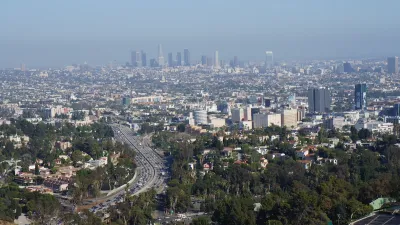A research study has found that increasing house sizes in the Los Angeles area have drastically reduced the number of trees shading the region's landscapes—regardless of geographic location of socioeconomic status.

Researchers with the USC Spatial Sciences Institute, led by Su Jin Lee, Professor Travis Longcore, Catherin Rich, and John P. Wilson have published a study finding that green cover for single-family home lots declined anywhere from 14 to 55 percent the Los Angeles area, with almost no single area spared from decline.
The study was published in the journal Urban Forestry & Urban Greening and announced in a press release on EurekaAlert.
As noted in the study, much of the "de-greening" of Los Angeles occurred as the city implemented a "Million Trees" campaign. The researchers began by taking an inventory of single-family parcels in the largest 20 largest cities in the Los Angeles basin, starting with the parcels that had added square footage to the home since 2007.
Baldwin Park led all areas in reduction, seeing a 55 percent loss of green cover on single-family residential lots in the mere span of nine years.
Other areas in the study that had at least 20 percent loss in cover included Pomona, Downey, Sylmar, Compton, and San Pedro/Port of Los Angeles.
The study noted one prominent exception: Pasadena, which maintained its verdant condition.
"[Study author] Longcore believes changing social views on the preferred size of single-family homes is the largest driver of tree cover loss, along with the increase in paved surfaces like walkways, driveways and swimming pools that come with home expansion," according to the press release.
FULL STORY: When single-family homes killed L.A.'s urban forest

Planetizen Federal Action Tracker
A weekly monitor of how Trump’s orders and actions are impacting planners and planning in America.

Maui's Vacation Rental Debate Turns Ugly
Verbal attacks, misinformation campaigns and fistfights plague a high-stakes debate to convert thousands of vacation rentals into long-term housing.

Cuomo Is the Candidate of Both NIMBYs and Developers. What Gives?
In the New York City mayoral race, odd bedfellows align to preserve the housing status quo.

San Antonio and Austin are Fusing Into one Massive Megaregion
The region spanning the two central Texas cities is growing fast, posing challenges for local infrastructure and water supplies.

Charlottesville Temporarily Has No Zoning Code
A judge ordered the Virginia city to throw out its newly revised zoning code, leaving permitting for new development in legal limbo.

In California Battle of Housing vs. Environment, Housing Just Won
A new state law significantly limits the power of CEQA, an environmental review law that served as a powerful tool for blocking new development.
Urban Design for Planners 1: Software Tools
This six-course series explores essential urban design concepts using open source software and equips planners with the tools they need to participate fully in the urban design process.
Planning for Universal Design
Learn the tools for implementing Universal Design in planning regulations.
Heyer Gruel & Associates PA
JM Goldson LLC
Custer County Colorado
City of Camden Redevelopment Agency
City of Astoria
Transportation Research & Education Center (TREC) at Portland State University
Jefferson Parish Government
Camden Redevelopment Agency
City of Claremont





























